
While adoption was slow at the start, Mattel’s leaders went on a road show armed with market data to help retailers create the right commercial environment for the more inclusive offerings—one in which diverse dolls were featured prominently, rather than on a bottom shelf. Eventually, the in-store environment began to change, and so did sales. Today, Barbie comes in 35 skin tones, 97 hair types, and nine body types. Mattel’s Hispanic, red-haired Barbie became a bestseller. The company also has dolls representing people with disabilities, both physical and cognitive. For example, it developed a doll with Down syndrome in collaboration with the National Down Syndrome Society. Mattel’s inclusion strategy affected all areas of the brand—product design, distribution, and commercial activities—and coincided with a period of significant growth. Barbie revenues increased 63% from 2015 to 2022—before the boost from the film.